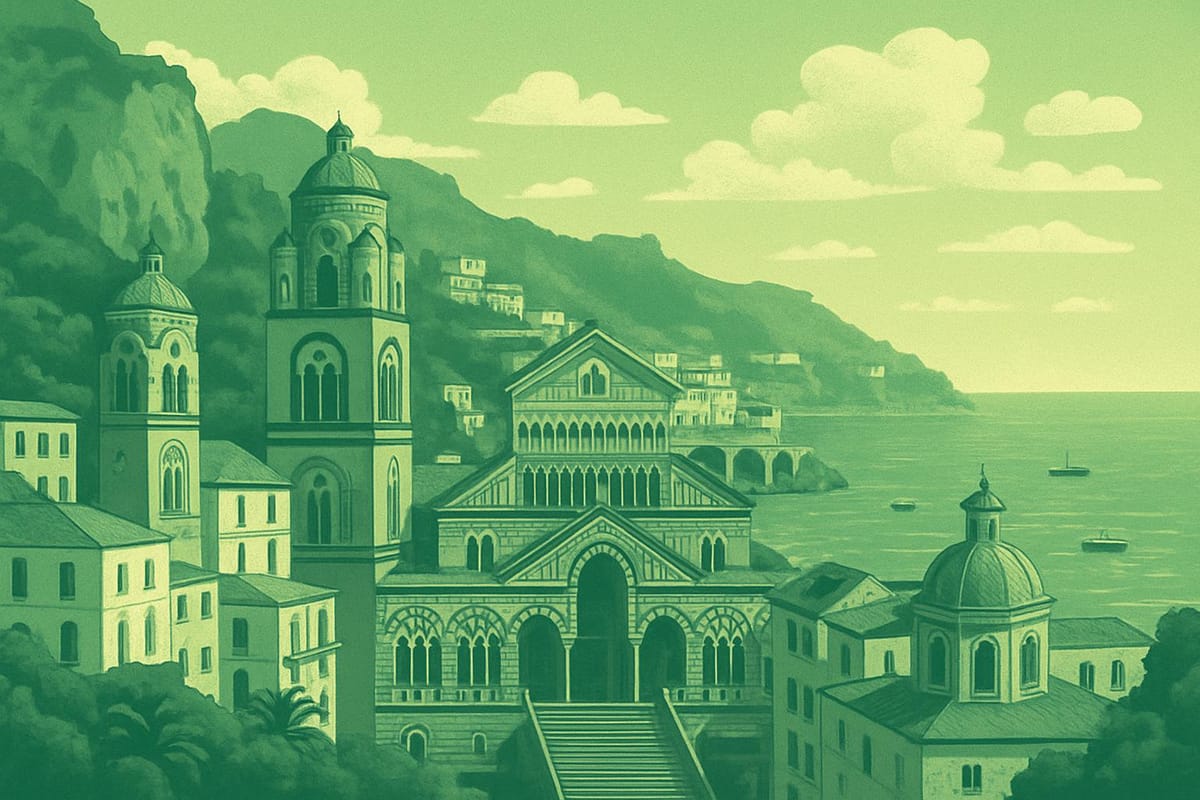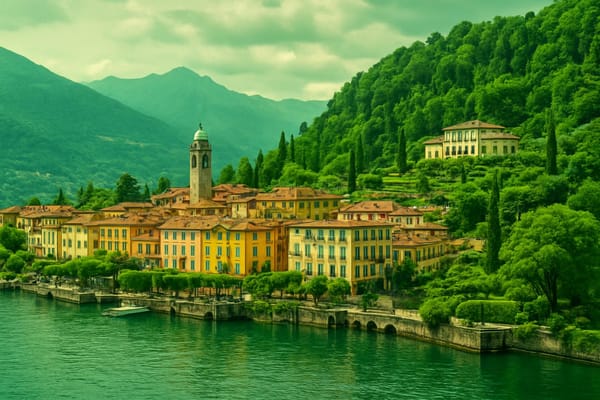Amalfi
Cliffside charm, limoncello, boat tours, historic cathedral, beaches & stunning sea views.

Important things to know about Amalfi
Amalfi, Italy, is a coastal city where sunlight and salt air shape daily life, its narrow lanes and stepped alleys threaded between pastel houses that cling to limestone cliffs overlooking the Mediterranean, creating an unmistakable sense of place that feels both timeless and vibrant; the rhythm here is set by fishing boats returning at dawn, cafés greeting locals with espresso and conversation, and the steady pulse of olive groves and lemon terraces that scent the breeze and inspire local flavors like limoncello and seafood stews simmered with herbs. This southern Italian town blends a rich maritime history with contemporary rhythms: families maintain artisanal trades and small-scale agriculture while entrepreneurs open boutique workshops and eateries that honor tradition without freezing it in time. The urban fabric is intimate and walkable, encouraging encounters in small piazzas and along the seafront, where fishermen, residents and visitors share the compact harbor life; architecture reflects centuries of layers, from stuccoed façades and tiled roofs to cobbled passages that descend toward the water, while light plays across stone and sea to produce striking seasonal moods. Living in Amalfi means adapting to a landscape that is both generous and demanding-steep streets, changing weather, and nature’s dramas-yet those challenges foster a strong local identity rooted in community, food culture, and respect for craftsmanship. Whether described for travel planning or cultural interest, Amalfi stands out as a quintessential example of coastal Italian living, offering authenticity, sensory richness, and the magnetic charm of the Amalfi Coast.
Sightseeing hot-spots in Amalfi
Amalfi sits like a jewel on the cliffs of the Amalfi Coast, where every narrow street and sunlit terrace invites visitors to slow down and savor southern Italy’s charms. Wandering the historic center reveals pastel buildings, fragrant lemon groves, and tiny artisan shops that preserve centuries-old traditions. The town’s compact layout makes it ideal for sightseeing on foot, allowing travelers to discover hidden courtyards, bustling cafés, and the lively Piazza del Duomo where locals and tourists mingle beneath the shade of umbrellas and bougainvillea.
The centerpiece of Amalfi’s cultural life is the majestic Duomo di Amalfi, a striking cathedral whose Arab-Norman façade and ornate interior offer a glimpse into the region’s layered history. Nearby, the peaceful Cloister of Paradise and the ancient Paper Museum speak to Amalfi’s medieval prosperity and craftsmanship, while museums and churches contain art and relics that attract history lovers. Strolling the winding lanes, you’ll find family-run restaurants serving fresh seafood and signature limoncello, and artisan stores showcasing handmade ceramics and stationery - all part of the authentic Amalfi sightseeing experience.
Beyond the town itself, Amalfi serves as a gateway to dramatic coastal scenery and unforgettable excursions. The pebbled shores of Marina Grande, sparkling boat tours to Positano and hidden sea caves, and the emerald glow of the Grotta dello Smeraldo make the coastline irresistible. Adventurous visitors can hike sections of the famed Path of the Gods for panoramic views of cliffs and sea, while sunset promenades along the harbor provide perfect photo opportunities. Whether you come for history, food, or breathtaking vistas, Amalfi on the Amalfi Coast delivers a rich mix of sights that linger long after you leave.
Hotels to enjoy in Amalfi
Amalfi offers an irresistible range of hotels in Amalfi that cater to every traveler seeking the magic of the Amalfi Coast. From restored convents and charming boutique guesthouses tucked into narrow lanes to luxury properties with rooftop terraces, guests can expect panoramic views, modern comforts, and easy access to the sea. Many accommodations pride themselves on sea view rooms and beachfront access that showcase the dramatic cliffs and azure water typical of Amalfi Italy, while others focus on an intimate local atmosphere with handcrafted decor and family-run service. Whether you prioritize a central location steps from the cathedral and cafes, or a tranquil perch above the town for sunset vistas, the diversity of hotels in Amalfi makes it simple to match your stay to your travel style.
Booking well in advance is smart because the best properties fill quickly during high season; searching for the best hotels in Amalfi with flexible dates often reveals quieter rates and special offers. Choose accommodation that includes local experiences like fresh local cuisine, guided boat trips, and suggestions for walking trails to fully enjoy the coast. Practical amenities such as shuttle service, on-site dining, and parking can be decisive if you plan day trips along the coast. Travelers who aim to combine convenience and charm should look for places advertising family-friendly rooms or suites and easy access to ferry connections. With thoughtful planning and a focus on authentic experiences, your stay among hotels in Amalfi will be memorable, blending historic Italian elegance with the unmistakable energy of the coastline.
Restaurants to try in Amalfi
The restaurants of Amalfi capture the essence of the Amalfi Coast with a blend of sunlit terraces, sea breezes and kitchens that celebrate fresh seafood and rustic Italian cuisine. Wander the narrow lanes and you’ll find family-run trattorie where plates of spaghetti alle vongole, grilled fish and bright lemon-infused sauces arrive alongside local white wines from Campania. Dining here is as much about the view as the menu: many eateries perch on cliffs or open onto tiny piazzas, offering diners a panorama of the Tyrrhenian Sea and a soundtrack of gulls and distant waves. Chefs in Amalfi emphasize seasonal produce-ripe tomatoes, fragrant basil, and the region’s famous Amalfi lemons-so every meal feels rooted in local tradition and the coastal terroir.
Exploring Amalfi’s culinary scene, visitors can choose from elegant fine-dining rooms to casual osterias where the focus is comfort and authenticity, and where recipes are passed down through generations. The best restaurants balance innovation with respect for classic flavors: think fresh catches prepared with modern techniques, or reinvented desserts starring limoncello and lemon creams. Food lovers seeking an unforgettable dining experience should sample the house specialties and pair them with a crisp Falanghina or Fiano for a true taste of the region. Whether you seek panoramic sea-view dinners, cozy indoor meals, or small plates at a bustling counter, Amalfi’s restaurant scene delivers a sensory journey through the coast’s culinary heritage and its vibrant, sun-drenched flavors.
Best shopping stops in Amalfi
Amalfi is a paradise for shopping lovers who want to combine scenic strolls with authentic finds; the compact old town makes shopping in Amalfi feel like a treasure hunt, with narrow lanes lined by artisan shops and family-run boutiques. From hand-painted ceramics adorned with bright lemons to delicate paper and stationery produced by historic local workshops, every purchase tells a story of craft and tradition. Food-focused shopping highlights include jars of fragrant limoncello, bottles of local olive oil, and packaged sweets infused with Amalfi’s signature citrus - perfect souvenirs that capture the taste of the Amalfi Coast. For those seeking wearable mementos, look for finely made leather sandals and light linen pieces designed for Mediterranean living; small ateliers often tailor items or offer custom finishes, making each piece uniquely Amalfi.
Beyond the postcard-perfect products, Amalfi’s shopping scene rewards patient browsing and friendly conversation with shop owners who are proud to explain their craft, which elevates the experience of Amalfi shopping from mere retail into cultural discovery. Boutique fashion houses and independent designers share space with markets where you can find fresh local produce and seasonal specialties, creating an appealing blend of modern style and traditional goods. Practical tips for maximizing your time include arriving early to avoid crowds and asking about tax-free shopping options if you are visiting from abroad. Whether you are hunting for handcrafted pottery, lemon-infused delicacies, or a chic Mediterranean wardrobe, shopping on the Amalfi Coast offers memorable finds, genuine craftsmanship, and the picturesque backdrop that makes every purchase feel like part of the trip.
Nightlife highlights in Amalfi
The Amalfi nightlife comes alive as the sun dips behind the cliffs, turning the harbor into a glittering stage where locals and travelers mingle on seafront bars and cocktail terraces. Strolling along the promenade, you’ll find intimate wine bars pouring crisp local wine, bustling cafes serving late-night bites, and chic terraces perfect for watching the sunset over the Mediterranean. Evenings are ideal for sampling Amalfi’s fresh seafood at family-run trattorie, followed by a relaxed drink while the salt-scented air carries the sound of laughter and distant waves. This blend of cozy charm and spirited energy captures the unique vibe of nightlife in Amalfi, offering both romantic escapes and lively social scenes.
As night deepens, the pace shifts toward live music and small clubs where acoustic sets, DJs, and jazz nights set the tempo for the Amalfi Coast nightlife experience. Piazza Duomo becomes a hub of activity, with street performers and alfresco dining creating a festive atmosphere that lasts into the early hours. For a memorable end to the evening, consider a night cruise to admire illuminated cliffside villages or grab a gelato and join the late strolls through narrow lanes. These nightlife highlights make Amalfi, Italy a destination where culture, cuisine, and conviviality blend effortlessly after dark.
Getting around in Amalfi
Amalfi’s transport scene is defined by its dramatic coastline and the practical reality that Amalfi has no train station, so most visitors arrive via nearby hubs: Naples International Airport (Napoli Capodichino) is the closest major airport for international flights, while Salerno and its small Costa d’Amalfi Airport offer limited regional options; from airports you’ll typically continue by a combination of train, bus, ferry or private transfer. Trains run to Napoli Centrale and Salerno, with the Circumvesuviana line serving Sorrento, and from those railheads frequent SITA bus services and ferries connect to Amalfi-summer ferries from Salerno and Naples are a scenic, fast option, while buses traverse the winding SS163 Amalfitana road year‑round. Driving yields spectacular views but narrow roads and scarce parking, so many travelers prefer a mix of train + ferry or pre‑booked private transfer for door‑to‑door convenience; taxis and shared shuttles are available but can be costly. For seamless travel, plan transfers in advance, check seasonal ferry timetables, and allow extra time for traffic on the Amalfi Coast to ensure you enjoy the journey as much as the destination.
Culture must-see's in Amalfi
Amalfi, Italy, is a compact treasure trove of Mediterranean history where the Duomo di Amalfi dominates the skyline and the cobbled Piazza Duomo invites lingering conversation. The town’s legacy as a powerful Maritime Republic still echoes in its museum collections and the narrow lanes that once hosted merchants from across the Mediterranean. Visitors can trace a living thread of craftsmanship in the centuries-old paper-making tradition-often called Amalfi paper-with historic mills that produced high-quality parchment for Europe’s libraries. The architecture blends Arab-Norman influences and Baroque flourishes, creating a unique backdrop for exploring the culture of Amalfi and how it shaped trade, religion, and art in southern Italy. This cultural continuity, set against the cliffs of the Amalfi Coast, is a powerful draw for travelers seeking both history and authentic Italian atmosphere.
Today Amalfi’s cultural highlights unfurl through vibrant festivals, culinary rituals, and seaside customs that define life on the Amalfi Coast, Italy. Seasonal celebrations such as the Feast of Sant’Andrea and the historic regattas reinforce communal identity, while local gastronomy showcases fragrant lemons, handmade pasta, and the beloved limoncello liqueur-symbols of coastal produce and Mediterranean flavor. Galleries, music events, and artisan shops offer contemporary expressions of tradition: ceramics, tapestry and paper goods link past techniques to modern design. Whether arriving by boat or winding down scenic coastal roads, visitors encounter a layered cultural experience where history, religion, food, and craftsmanship combine to make Amalfi an essential cultural destination on the Amalfi Coast.
History of Amalfi
Amalfi's history begins long before it became the iconic jewel of the Amalfi Coast, rooted in a strategic position on the Mediterranean that fostered maritime ambition and cultural exchange. From late antiquity through the early medieval period, the town grew into the Republic of Amalfi, a remarkable medieval maritime republic that rivaled Genoa, Pisa and Venice. By the 9th and 10th centuries Amalfi had become a hub of seafaring commerce, its ships and merchants navigating routes that linked the Byzantine and Arab worlds, carrying not only goods but ideas, art and legal customs. The famed Tabula Amalphitana, a maritime code attributed to Amalfi, influenced seaborne law across the Mediterranean and stands as tangible evidence of the town’s influence. Wealth from trade in grain, spices, silk, and luxury goods funded ambitious civic projects, notably the construction of the Duomo di Amalfi, with its striking Arab-Norman facade and elaborate interior that reflect the town’s multicultural interactions. Inland, the proliferation of paper mills and textile workshops supported crafts that furthered Amalfi’s economic reach; the production of paper in the Valle dei Mulini and nearby valleys became a defining local industry that complemented maritime commerce and administrative sophistication during Amalfi’s heyday in the 11th century.
The later history of Amalfi is a story of dramatic rise, decline, and renaissance, shaped by shifting political fortunes and changing economic currents. The arrival of the Normans and the ascendancy of rival maritime powers gradually eroded Amalfi’s independence, and by the 13th century the republic’s political autonomy had effectively ended, its maritime supremacy overtaken. Over subsequent centuries Amalfi weathered earthquakes, pirate raids, and a slow economic ebb, yet the town retained its artistic and architectural heritage. The modern revival, beginning in the 19th and 20th centuries, transformed Amalfi into a destination of cultural tourism and international fascination, attracting visitors drawn to its historic cathedral, narrow Byzantine streets, and panoramic cliffside vistas. Today Amalfi is not only a symbol of coastal Italian beauty but also a living museum of Mediterranean history and cross-cultural exchange, its legacy enshrined within the broader recognition of the Amalfi Coast as an area of outstanding cultural and natural value. Whether studied for its contributions to medieval law, maritime commerce, or Mediterranean art and architecture, Amalfi continues to captivate historians, travelers and scholars interested in the layered, resilient story of a city that once steered the waves of the medieval world.



